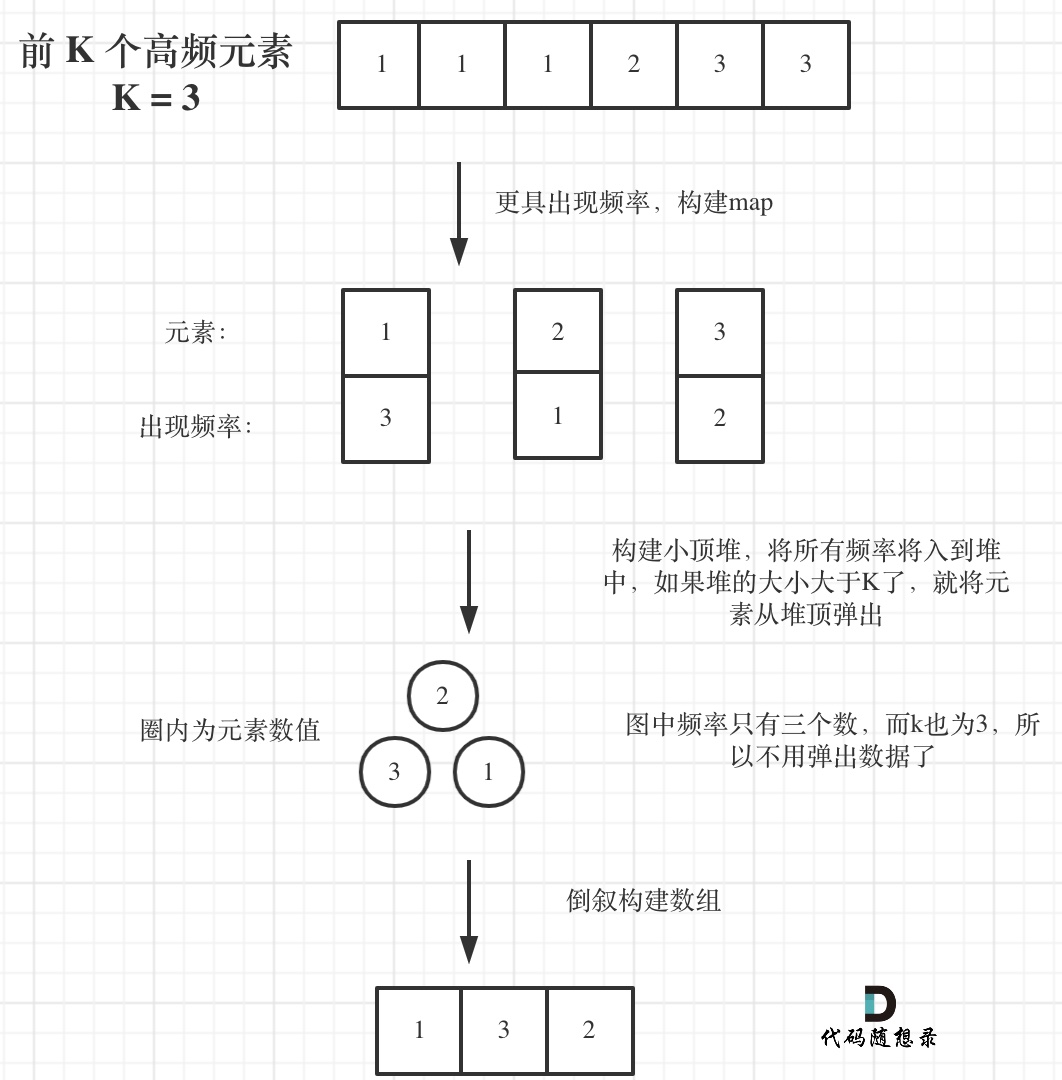参与本项目,贡献其他语言版本的代码,拥抱开源,让更多学习算法的小伙伴们收益!
前K个大数问题,老生常谈,不得不谈
给定一个非空的整数数组,返回其中出现频率前 k 高的元素。
示例 1:
- 输入: nums = [1,1,1,2,2,3], k = 2
- 输出: [1,2]
示例 2:
- 输入: nums = [1], k = 1
- 输出: [1]
提示:
- 你可以假设给定的 k 总是合理的,且 1 ≤ k ≤ 数组中不相同的元素的个数。
- 你的算法的时间复杂度必须优于
$O(n \log n)$ , n 是数组的大小。 - 题目数据保证答案唯一,换句话说,数组中前 k 个高频元素的集合是唯一的。
- 你可以按任意顺序返回答案。
这道题目主要涉及到如下三块内容:
- 要统计元素出现频率
- 对频率排序
- 找出前K个高频元素
首先统计元素出现的频率,这一类的问题可以使用map来进行统计。
然后是对频率进行排序,这里我们可以使用一种 容器适配器就是优先级队列。
什么是优先级队列呢?
其实就是一个披着队列外衣的堆,因为优先级队列对外接口只是从队头取元素,从队尾添加元素,再无其他取元素的方式,看起来就是一个队列。
而且优先级队列内部元素是自动依照元素的权值排列。那么它是如何有序排列的呢?
缺省情况下priority_queue利用max-heap(大顶堆)完成对元素的排序,这个大顶堆是以vector为表现形式的complete binary tree(完全二叉树)。
什么是堆呢?
堆是一棵完全二叉树,树中每个结点的值都不小于(或不大于)其左右孩子的值。 如果父亲结点是大于等于左右孩子就是大顶堆,小于等于左右孩子就是小顶堆。
所以大家经常说的大顶堆(堆头是最大元素),小顶堆(堆头是最小元素),如果懒得自己实现的话,就直接用priority_queue(优先级队列)就可以了,底层实现都是一样的,从小到大排就是小顶堆,从大到小排就是大顶堆。
本题我们就要使用优先级队列来对部分频率进行排序。
为什么不用快排呢, 使用快排要将map转换为vector的结构,然后对整个数组进行排序, 而这种场景下,我们其实只需要维护k个有序的序列就可以了,所以使用优先级队列是最优的。
此时要思考一下,是使用小顶堆呢,还是大顶堆?
有的同学一想,题目要求前 K 个高频元素,那么果断用大顶堆啊。
那么问题来了,定义一个大小为k的大顶堆,在每次移动更新大顶堆的时候,每次弹出都把最大的元素弹出去了,那么怎么保留下来前K个高频元素呢。
而且使用大顶堆就要把所有元素都进行排序,那能不能只排序k个元素呢?
所以我们要用小顶堆,因为要统计最大前k个元素,只有小顶堆每次将最小的元素弹出,最后小顶堆里积累的才是前k个最大元素。
寻找前k个最大元素流程如图所示:(图中的频率只有三个,所以正好构成一个大小为3的小顶堆,如果频率更多一些,则用这个小顶堆进行扫描)
我们来看一下C++代码:
// 时间复杂度:O(nlogk)
// 空间复杂度:O(n)
class Solution {
public:
// 小顶堆
class mycomparison {
public:
bool operator()(const pair<int, int>& lhs, const pair<int, int>& rhs) {
return lhs.second > rhs.second;
}
};
vector<int> topKFrequent(vector<int>& nums, int k) {
// 要统计元素出现频率
unordered_map<int, int> map; // map<nums[i],对应出现的次数>
for (int i = 0; i < nums.size(); i++) {
map[nums[i]]++;
}
// 对频率排序
// 定义一个小顶堆,大小为k
priority_queue<pair<int, int>, vector<pair<int, int>>, mycomparison> pri_que;
// 用固定大小为k的小顶堆,扫面所有频率的数值
for (unordered_map<int, int>::iterator it = map.begin(); it != map.end(); it++) {
pri_que.push(*it);
if (pri_que.size() > k) { // 如果堆的大小大于了K,则队列弹出,保证堆的大小一直为k
pri_que.pop();
}
}
// 找出前K个高频元素,因为小顶堆先弹出的是最小的,所以倒序来输出到数组
vector<int> result(k);
for (int i = k - 1; i >= 0; i--) {
result[i] = pri_que.top().first;
pri_que.pop();
}
return result;
}
};大家对这个比较运算在建堆时是如何应用的,为什么左大于右就会建立小顶堆,反而建立大顶堆比较困惑。
确实 例如我们在写快排的cmp函数的时候,return left>right 就是从大到小,return left<right 就是从小到大。
优先级队列的定义正好反过来了,可能和优先级队列的源码实现有关(我没有仔细研究),我估计是底层实现上优先队列队首指向后面,队尾指向最前面的缘故!
Java:
class Solution {
public int[] topKFrequent(int[] nums, int k) {
int[] result = new int[k];
HashMap<Integer, Integer> map = new HashMap<>();
for (int num : nums) {
map.put(num, map.getOrDefault(num, 0) + 1);
}
Set<Map.Entry<Integer, Integer>> entries = map.entrySet();
// 根据map的value值正序排,相当于一个小顶堆
PriorityQueue<Map.Entry<Integer, Integer>> queue = new PriorityQueue<>((o1, o2) -> o1.getValue() - o2.getValue());
for (Map.Entry<Integer, Integer> entry : entries) {
queue.offer(entry);
if (queue.size() > k) {
queue.poll();
}
}
for (int i = k - 1; i >= 0; i--) {
result[i] = queue.poll().getKey();
}
return result;
}
}Python:
#时间复杂度:O(nlogk)
#空间复杂度:O(n)
import heapq
class Solution:
def topKFrequent(self, nums: List[int], k: int) -> List[int]:
#要统计元素出现频率
map_ = {} #nums[i]:对应出现的次数
for i in range(len(nums)):
map_[nums[i]] = map_.get(nums[i], 0) + 1
#对频率排序
#定义一个小顶堆,大小为k
pri_que = [] #小顶堆
#用固定大小为k的小顶堆,扫面所有频率的数值
for key, freq in map_.items():
heapq.heappush(pri_que, (freq, key))
if len(pri_que) > k: #如果堆的大小大于了K,则队列弹出,保证堆的大小一直为k
heapq.heappop(pri_que)
#找出前K个高频元素,因为小顶堆先弹出的是最小的,所以倒序来输出到数组
result = [0] * k
for i in range(k-1, -1, -1):
result[i] = heapq.heappop(pri_que)[1]
return resultGo:
//方法一:小顶堆
func topKFrequent(nums []int, k int) []int {
map_num:=map[int]int{}
//记录每个元素出现的次数
for _,item:=range nums{
map_num[item]++
}
h:=&IHeap{}
heap.Init(h)
//所有元素入堆,堆的长度为k
for key,value:=range map_num{
heap.Push(h,[2]int{key,value})
if h.Len()>k{
heap.Pop(h)
}
}
res:=make([]int,k)
//按顺序返回堆中的元素
for i:=0;i<k;i++{
res[k-i-1]=heap.Pop(h).([2]int)[0]
}
return res
}
//构建小顶堆
type IHeap [][2]int
func (h IHeap) Len()int {
return len(h)
}
func (h IHeap) Less (i,j int) bool {
return h[i][1]<h[j][1]
}
func (h IHeap) Swap(i,j int) {
h[i],h[j]=h[j],h[i]
}
func (h *IHeap) Push(x interface{}){
*h=append(*h,x.([2]int))
}
func (h *IHeap) Pop() interface{}{
old:=*h
n:=len(old)
x:=old[n-1]
*h=old[0:n-1]
return x
}
//方法二:利用O(logn)排序
func topKFrequent(nums []int, k int) []int {
ans:=[]int{}
map_num:=map[int]int{}
for _,item:=range nums {
map_num[item]++
}
for key,_:=range map_num{
ans=append(ans,key)
}
//核心思想:排序
//可以不用包函数,自己实现快排
sort.Slice(ans,func (a,b int)bool{
return map_num[ans[a]]>map_num[ans[b]]
})
return ans[:k]
}javaScript:
/**
* @param {number[]} nums
* @param {number} k
* @return {number[]}
*/
var topKFrequent = function(nums, k) {
const map = new Map();
for(const num of nums) {
map.set(num, (map.get(num) || 0) + 1);
}
// 创建小顶堆
const priorityQueue = new PriorityQueue((a, b) => a[1] - b[1]);
// entry 是一个长度为2的数组,0位置存储key,1位置存储value
for (const entry of map.entries()) {
priorityQueue.push(entry);
if (priorityQueue.size() > k) {
priorityQueue.pop();
}
}
const ret = [];
for(let i = priorityQueue.size() - 1; i >= 0; i--) {
ret[i] = priorityQueue.pop()[0];
}
return ret;
};
function PriorityQueue(compareFn) {
this.compareFn = compareFn;
this.queue = [];
}
// 添加
PriorityQueue.prototype.push = function(item) {
this.queue.push(item);
let index = this.queue.length - 1;
let parent = Math.floor((index - 1) / 2);
// 上浮
while(parent >= 0 && this.compare(parent, index) > 0) {
// 交换
[this.queue[index], this.queue[parent]] = [this.queue[parent], this.queue[index]];
index = parent;
parent = Math.floor((index - 1) / 2);
}
}
// 获取堆顶元素并移除
PriorityQueue.prototype.pop = function() {
const ret = this.queue[0];
// 把最后一个节点移到堆顶
this.queue[0] = this.queue.pop();
let index = 0;
// 左子节点下标,left + 1 就是右子节点下标
let left = 1;
let selectedChild = this.compare(left, left + 1) > 0 ? left + 1 : left;
// 下沉
while(selectedChild !== undefined && this.compare(index, selectedChild) > 0) {
// 交换
[this.queue[index], this.queue[selectedChild]] = [this.queue[selectedChild], this.queue[index]];
index = selectedChild;
left = 2 * index + 1;
selectedChild = this.compare(left, left + 1) > 0 ? left + 1 : left;
}
return ret;
}
PriorityQueue.prototype.size = function() {
return this.queue.length;
}
// 使用传入的 compareFn 比较两个位置的元素
PriorityQueue.prototype.compare = function(index1, index2) {
if (this.queue[index1] === undefined) {
return 1;
}
if (this.queue[index2] === undefined) {
return -1;
}
return this.compareFn(this.queue[index1], this.queue[index2]);
}TypeScript:
function topKFrequent(nums: number[], k: number): number[] {
const countMap: Map<number, number> = new Map();
for (let num of nums) {
countMap.set(num, (countMap.get(num) || 0) + 1);
}
// tS没有最小堆的数据结构,所以直接对整个数组进行排序,取前k个元素
return [...countMap.entries()]
.sort((a, b) => b[1] - a[1])
.slice(0, k)
.map(i => i[0]);
};

